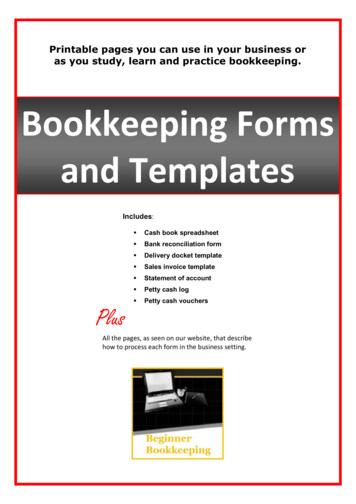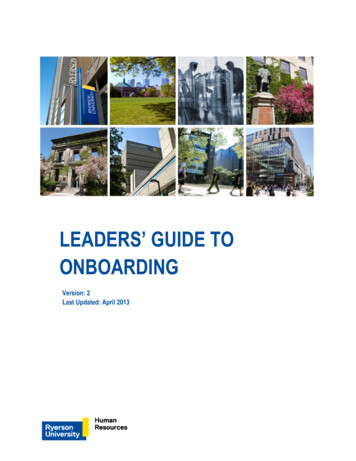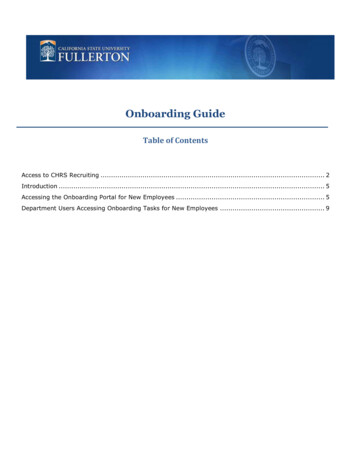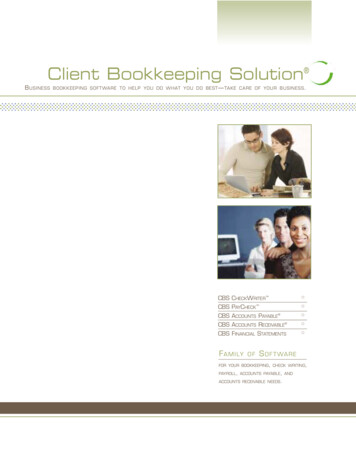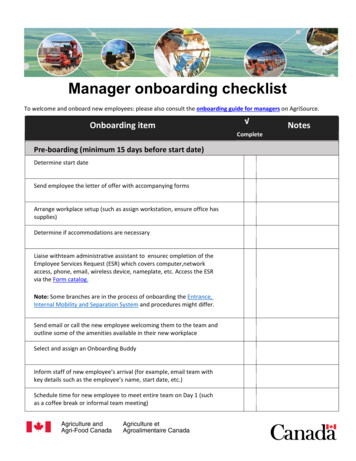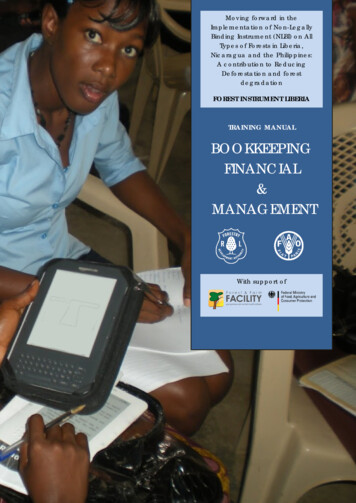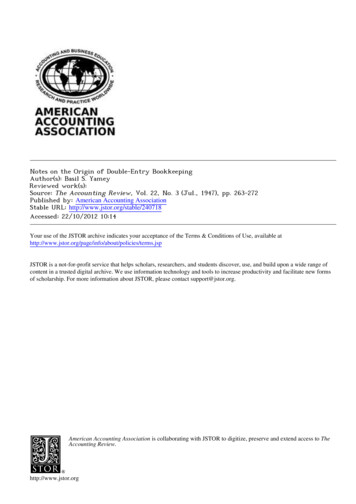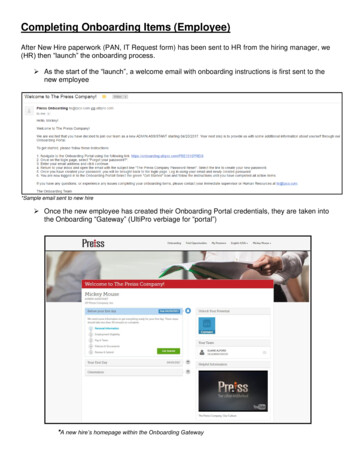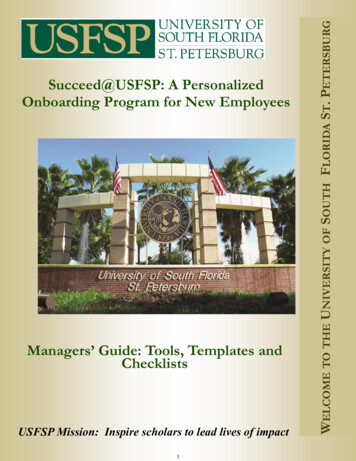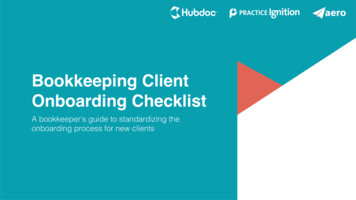
Transcription
Bookkeeping ClientOnboarding ChecklistA bookkeeper's guide to standardizing theonboarding process for new clients
Table of ContentsWhy is it important to standardize your client onboarding process? . 03Before onboarding . 04Understand your business model and establish your services . 04Define your ideal client . 05Standardize your accounting technology stack . 05Who should be involved in the onboarding process? . 06What’s the ideal onboarding time frame? . 06For quick access to the checklist,click here!VIEW CHECKLISTClient onboarding process & checklist . 07Receive contract & send welcome email . 08Gather client information . 09Set up project & apps . 11Client kickoff meeting . 12Send a welcome package . 13Transition to bookkeeping team . 14Standardize & evaluate . 15Appendices . 16Appendix A: Using Zapier to Automate Your Onboarding . 17Appendix B: List of Requested Client Information . 19Appendix C: Firm "Cheat Sheet" Template . 22Acknowledgements . 2302
Why is it important to standardize yourclient onboarding process?Onboarding – the process of familiarizing a new client withyour firm’s products or services – is a critical part of yourclient experience. It is the fundamental phase in which yourfirm sets expectations for how you and your client will work together to achieve their business goals. An incredible onboarding process will help you and your client “start off onthe right foot” and set the standard for the rest of your client’sexperiences working with you and your firm.Onboarding isn’t exclusive to new clients, as you will also onboard existing clients when your firm introduces a new service, process, and/or tool. However, onboarding is one of themost important stages when bringing on a new client as itbuilds the foundation of your relationship.Kicking off your client relationship with an incredible onboarding experience can yield massive returns for your accounting or bookkeeping practice. Onboarding your clientsproperly will lead to increased client retention, which increases profitability. In financial services, research shows that a5% increase in customer retention produces more than a25% increase in profit.Or, to offer a summary by Lincoln Murphy (author of Customer Success: How Innovative Companies are ReducingChurn and Growing Recurring Revenue): “Proper onboardingisn't done to prevent churn; it's done to ensure the customerachieves their desired outcome. Retention comes from that.”However, many firms delay or fail to see the need to standardize their new client onboarding process. Although everyfirm operates differently – and should, depending on yoursize, goals, the types of clients you serve, and so on – standardizing your onboarding process should be a priority as itwill provide the structure from which you can measure performance. The ability to measure will allow your firm to increaseefficiency and effectively scale.This checklist will provide you with a high-level frameworkwhich you can use to standardize your firm’s onboarding process for your new bookkeeping clients.03
Before onboardingIn order to standardize your onboarding process in a waythat will achieve optimal results, it’s important to get a fewthings in place at your firm first. Making these core businessdecisions will help streamline your onboarding process andultimately provide a better experience for your clients. Moreover, they’ll help you avoid having to completely re-engineeryour onboarding process later on – establishing the followingitems will at least put your firm on the right path, from whichyou can iterate as your firm scales and you optimize your onboarding process.Understand your business model andestablish your services.This might sound simple, but before you bring on new clients,it’s critical to define the level of service you provide for eachof your firm’s products and services. Specify the frequency,location (i.e., whether it’s completed on-site or off-site), theexact deliverables related to each service, and the maximumwork provided, if applicable.For monthly bookkeeping, for example, it could be helpful toinclude whether or not transactions will be recorded, thebank feed will be matched, accounts reconciled, and theperiod closed. Does it include a monthly Controller Call? Es-tablish the maximum number of accounts or transactions thatare included (if applicable) and whether or not class, location, and job tracking are included.Once you have clearly defined the service delivery expectation, you can document for your staff exactly how the workshould be performed, as well as create a fixed price for theservice.The following resources will help you to define your servicesand introduce a fixed pricing structure at your firm:Best Practice: Writing Service DescriptionsThis guide includes a recommended framework forwriting service descriptions, as well as providessome ideas for how you can structure your services.How to Successfully Build & Implement a FixedFee Pricing Plan at Your PracticeWatch this webinar recording for a step-by-stepguide on how to introduce a fixed pricing structure atyour firm.04
Before onboarding (cont’d)Define your ideal client.Clearly defining the types of clients your firm wants to workwith (and, just as importantly, the types of clients your firmdoes not want to work with) will also help when standardizingyour onboarding process. Making the decision to only workwith clients who share similar business needs and processeswill not only make standardization of your onboarding process easier – it will also make your onboarding process moreeffective.Sample Bookkeeping Technology StackContract Management &Automated Practice ARWorkflow ManagementAccounting SoftwareClient InteractionStandardize your accountingtechnology stack.Best-in-class firms usually operate using a standardizedtechnology “stack” of cloud accounting applications thathelp to automate every corner of their workflow (see an example to the right). The accounting and bookkeeping applications you use should be seen as an extension of your business – your onboarding process will be more effective if yourteam doesn’t have to learn a new set of tools every time a newclient comes on board.Internal CommunicationDocument CollectionBill PayCloud StorageExpense ManagementWorkflow AutomationTime TrackingRegional Payroll05USACanadaAustraliaAustralia
Who should be involved in the onboardingprocess?Some firms have a dedicated onboarding team or individualdedicated to client onboarding (e.g., an Onboarding Manager or Onboarding Specialist). This role acts as the main pointof communication during the transition from sales to the accounting/bookkeeping team (i.e., after the client has signed aproposal, and before the firm begins any compliance and advisory work).At a high-level, their key responsibilities usually include:Setting timelines and expectations for the onboarding processGathering the necessary client information (e.g., bank details)Assisting the client with app account setup and trainingTransitioning the client over to their dedicated accounting/bookkeeping teamIf your firm doesn’t have any plans on the horizon to establishan onboarding function, it’s critical to at least dedicate someone as the main point of contact to ensure the onboarding experience is enjoyable for the client.What’s the ideal onboarding timeframe?It is often cited that clients are most likely to churn within thefirst 90 days of starting a new product or service. As such,best practice would dictate that your client should be fully onboarded before they hit the 90-day mark with your firm.However, many best-in-class firms focus on making their onboarding process task-based, as opposed to timeline-based. Of course, the onboarding process shouldn’tdrag on, but there also shouldn’t be pressure to rushthrough it.In our checklist, we provide a suggested timeline for eachtask based on best practices; however, it's up to your firmand your clients to decide on an onboarding timeline thatworks for both of you.06
Start hereClient onboardingprocess & checklistReceive contract & sendwelcome emailGather client informationThe 6 stages of onboardingThis onboarding checklist will take you through each ofthese stages, outlining what must be achieved at eachstage, best practices for how it should be accomplished,and a list of suggested tasks required in order to move on tothe next stage.Set up project & appsSource: A Guide to Client Onboarding: 7 Steps to Happier Clients & Less Churnby Practice IgnitionClient kickoff meetingSend a welcome packageTransition tobookkeeping team07
Receive contract &send welcome emailAs soon as your client has signed their proposal/engagementletter, it’s off to the races! Have a set process in place forwhat happens immediately after a client signs on with yourfirm, and who is responsible for making it happen. Streamlineinternal communication as much as possible – announce keydetails to your entire firm, and start a Slack channel (or another communication channel) for the client’s dedicated team.When sending your “welcome” email, ensure your client’saction items are clearly laid out. Also, it should be noted thatsome clients will prefer other channels of communication(such as Slack). Decide on the preferred method of communication at this stage, then stick to it moving forward.PRO TIP:Automate using Zapier. Zapier is a handy tool thatallows users to integrate various web applications toautomate tasks. For example, you can integrate Zapierwith Practice Ignition to automatically inform your teamabout a new client in Slack, assign an onboarding taskin Aero Workflow, and send a “welcome” email – all immediately after a proposal has been accepted.See Appendix A: Using Zapier to Automate YourOnboarding.Checklist1TaskOwnerReceive and file signedcontract/engagement letter from client(note: filing contract not required whenusing Practice Ignition)StartDependent onprevious task?SalesEnd of proposalprocess.Admin 1 business day afterreceiving signed contractYesAssign internal team to your new client(Onboarding Specialist, BookkeepingTeam)Admin.Send welcome email to your client &schedule implementation call. Include:OnboardingWithin 2 business daysafter receiving signedcontractYesA warm welcome on behalf of your team.Introduction to onboarding specialist(s).Calendly link to schedule kickoff call.Request for information (ClientOnboarding Questionnaire).Follow client on social media (Twitter,Instagram, Facebook, LinkedIn)Marketing /AdminWithin 3 business days afterreceiving signed contractNoAdd client to email newsletterMarketing /AdminWithin 3 business days afterreceiving signed contractNoAdd client start date/birthday as a recurringannual event in your calendarAdminWithin 3 business days afterreceiving signed contractNoInform your team about the new clientOther:08
ChecklistTaskGather clientinformationGathering client information is perhaps the most importantpart of your onboarding process. Missing information will holdup other onboarding processes and cause frustration for theclient if you’re bombarding their inbox with requests.The key to gathering client information is streamlining the process as much as possible. The method through which yougather client information is important. Many best-in-classfirms use tools such as Google Forms or Typeform to collecteverything they need at once. Aim to gather information in away that is convenient for the client, easy to track, and, ofcourse, secure.Request your client information In your welcome email (or, asa follow up email to your initial welcome email – whateverworks best for your firm). Be sure to ask for all the informationyou need in order to set up their app accounts, etc.OwnerSet up and send an onboardingquestionnaire to your client (this can beautomated using Practice Ignition & Zapier)2StartDependent onprevious task?Onboarding10-15 business daysbefore kickoff meetingYesBusiness information (address, phonenumber, etc.).Main point of contact (name, email).Bank details & read-only bank access.User names & email addresses (for appsetup & permission level - will vary byapp).Metrics for success.Onboarding10-15 business daysbefore kickoff meetingYesConsent forms.Incorporation documents.Payroll information.Ask for:Other items to request (depending onclient):See Appendix B - List of Requested Client Information.PRO TIP:Don’t ask for the same piece of information twice.For example, if you can find the address of the firm ona document or form, don’t ask them to include it separately. This will save your client time (and avoid thefrustration that inevitably occurs from doing the samething twice).For a comprehensive list of items to request from new clients, please see:Appendix B - List of Requested Client Information.09
PRO TIP:Collect billing information during the proposal process. Firms are often uncertain as to the best time toask for billing information. If a client is willing to providepayment information (e.g., a pre-authorized debitagreement) during the proposal process, it’s a goodsign that they’ll be an ideal client. However, some firmsmight be unsure about this, and may be worried thattheir client won’t accept their proposal because you’reasking for payment information upfront. It’s worthnoting the following statistics from Practice Ignition in2017:In Australia: 76,669 proposals were sent throughPractice Ignition, of which 48,474 proposals asked forautomatic payments and payment information upfront.Of those 48,474 proposals, 93% were accepted bythe clients. 16,420 of the 48,474 had the paymentfields as a required field (meaning the client could notaccept the proposal without entering their information).This achieved a 91.5% acceptance rate.2In North America: these numbers were very similar,with an average acceptance rate of 91% betweenCanada and the USA, and a 90% average acceptance rate for proposals.10
ChecklistTaskOwnerStartDependent onprevious task?Set up onboarding job in your workflowmanagement tool which includes thefollowing steps (note: can be automatedwith Zapier)Onboarding10-15 business daysbefore kickoff meetingYesSet up recurring services to perform foryour client at the proper frequency inyour workflow management toolOnboarding10-15 business daysbefore kickoff meetingYesBook client kickoff meeting (in-person orvirtual)Onboarding10-15 business daysbefore kickoff meetingNoOnboarding &Bookkeeping10-15 business daysbefore kickoff meetingNoScope of project.Timelines and expectations.Scheduling and workflow.Onboarding5-10 business daysbefore kickoff meetingYesAccounting system (QuickBooks Online,Xero).Client interaction (Client Hub).Document collection & management(Hubdoc).PayrollBill pay (Bill.com, Plooto).ReportingCloud storage (Box, Dropbox, GoogleDrive, ShareFile, SmartVault).Expense management (Expensify).Time tracking (TSheets).Payroll (Gusto, Wagepoint, ADP).Reporting (Futrli, Fathom, SpotlightReporting).Set up project& appsYour client kickoff meeting (stage 4) will cover a number of administrative onboarding tasks that are more efficiently completed alongside the client (e.g., showing them how to uploadreceipts). However, it will help to streamline this client kickoffmeeting if you’re able to set up your onboarding workflow project and the recurring services that you will perform for your clients (using a tool such as Aero Workflow), as well as any oftheir cloud bookkeeping app accounts prior to the kickoffmeeting.For new monthly bookkeeping clients, this will likely includetheir accounting system, as well as tools for automating:Document collection & managementBill payCloud storageExpense managementTime trackingMeet internally - discuss:3Use client information to set up as manysystems as possible before client kickoffmeeting (as applicable):11
ChecklistTaskClient kickoffmeetingStartOnboarding5-10 business days beforekickoff meetingYesSend an agenda in advance – agendashould include introduction time, whatmust be accomplished (see below), andany outstanding information/itemsrequired from the client.3-5 business days beforekickoff meeting.Ensure your workspace is cleanwhether meeting in person or virtually. Ifmeeting virtually, ensure your webcam isworking and your appearance iscamera-ready – first impressions matter!.Day of kickoff meeting.Turn off all notifications and distractions.Day of kickoff meeting.OnboardingDuring kickoff meetingYesMake clients feel welcome and excited(especially when executingadministrative tasks).Set timelines and expectations.Onboard client to apps.Keep a list of any outstanding to-doitems.Onboarding 1 business day afterkickoff meeting.Summary of what has been set up.List of any outstanding to-do items andnext steps.Calendly link to book meeting withbookkeeping team.Onboarding.During kickoff meeting:What happens before and after your kickoff meeting is just asimportant as the meeting itself. It’s critical to communicatewith your client what is going to happen during the kickoff, aswell as clearly outlining what outstanding items they need todo after.Note: Prior to this stage (depending on the client and the typeof work you’re doing for them), it might be necessary for keystakeholders (e.g., partners and/or the bookkeeper leadingthe project) to meet to agree upon timelines and KPIs.OwnerPreparing for the kickoff meeting:Your kickoff meeting/call is also hugely important to yourworking relationship with your client as it will be the first timeyou’re truly collaborating with them. Kickoff calls can be challenging because a lot of “boring” administrative work must beaccomplished – it’s important to ensure that even these typesof tasks are engaging for your client. It helps to add context asto why you’re using the process/tool(s) you’re showing them(e.g., it will help them save time, improve accuracy, etc.).4Follow up after kickoff meeting - include:PRO TIP:Aim to keep kickoff calls under 1 hour. As mentioned, kickoff meetings are usually dominated by administrative tasks. Optimize the structure of your kickoff meetings so you use your client’s valuable timewisely.Dependent onprevious task?After kickoff meeting - internal tasks:Add users to apps. 5 business days afterkickoff meeting.Take care of any outstanding setup tasksbased on new client information.12
Send a welcomepackageChecklistSending a welcome package to your clients will enhance theirexperience and show that you’re invested in your relationshipwith them. In addition to providing important information aboutyour firm (e.g., a “cheat sheet” that includes contact information about your firm – this can be sent as part of your clientkickoff follow up, or separately), your welcome packageserves to warmly welcome your client as part of your team.TaskAssemble/order & send welcome package include:Sending a standard swag package and/or handwritten card isa great idea. Or, to go above and beyond, be thoughtful andpersonalize, if possible. Consider the following:What are the clients’ interests as a company? (E.g.,are they a local brewery, or are they a health foodstore?)Should it be a one-off gift, or a recurring monthlysubscription?What would really enhance your client’s experienceand show them that you appreciate their business?OwnerStartDependent onprevious task?Onboarding/Admin5-7 days after kickoffmeetingNoA firm "cheat sheet" that includes contactinformation (via email).A personalized "welcome" video fromyour team (via email; optional).Swag, gifts, and/or a handwritten card(be creative!).5See Appendix C - Firm “Cheat Sheet” Template.13
ChecklistTaskTransition to bookkeeping teamThe final stage of the onboarding process – transitioning theclient to their dedicated bookkeeper/bookkeeping team –occurs when:You have gathered all of the necessary informationfrom the clientAll of the client’s apps/accounts have been set upYour internal team has everything they need tobegin advisory services!Let the monthly bookkeeping begin!Onboarding/Bookkeeping1-3 business days afterall onboarding tasks arecompleteYesHost internal transition meeting - during themeeting:Onboarding/Bookkeeping3-5 business days afterall onboarding tasks arecompleteYesSet aside time for outstanding Q&Aabout apps & onboarding.Discuss any timelines and next steps toclose out onboarding.Discuss timelines and next steps formonthly bookkeeping process.Bookkeeping 1 business day aftertransition meetingYesList of any outstanding tasks & actionitems.Summary of next steps.Calendly link to book recurring meetingwith dedicated member of their assignedbookkeeping team.BookkeepingAs soon as transition toBookkeeping Team iscompletedYesBegin monthly bookkeeping!6StartSet up initial meeting with bookkeepingteamFollow up with client after transitionmeeting - include:The client has received training/information onhow to work with the appsOnce your onboarding process is standardized, most of thetasks listed above will occur leading up to and during the clientkickoff meeting. Of course, every client is different – the key isto have a set process in place for what happens after a clientcompletes onboarding, and who is responsible for guiding thetransition to monthly bookkeeping (similar to the handoff fromsales to onboarding).OwnerDependent onprevious task?14
Standardize & evaluateStandardizing your onboarding process doesn’t mean “set itand forget it” – rather, part of your standardization processrequires constantly evaluating any inefficiencies in the process and fixing them. For example, maybe you need togather more information from the client upfront. Or, maybeyou need to split your kickoff meeting into two shorter sessions, instead of one long one.The best way to figure out how the process can be improvedis to ask your clients directly. Use a Net Promoter Score(NPS) tool such as Promoter.io or Delighted to collect andevaluate this feedback.A great client experience starts with amazing onboarding.Standardize and improve this process to experience the benefits that unfold from strong client relationships.To view the checklist in Google Sheets, click below.VIEW CHECKLIST15
AppendicesAppendix A - Using Zapier to Automate Your OnboardingAppendix B - List of Requested Client InformationAppendix C - Firm “Cheat Sheet” Template
Appendix AUsing Zapier to Automate Your Onboarding (and So Much More!)By Tom Maxwell, Head of Customer Success at Practice IgnitionEvery single step detailed out in our Bookkeeping Client Onboarding Checklist is critical for determining the success orfailure of your relationship with your customer. But we are thefirst to admit, there’s a lot to do. Not only that, there’s also alot you need to get right each and every time you onboarda new client.So, how do you streamline this process even further withoutskipping steps or causing inconsistencies?Enter Zapier.Heather Satterley, a 20-year veteran certified tax agent, aQuickbooks ProAdvisor since 1999, and official Intuit Trainer,also happens to be a wizard at Zapier. In her blog, Zapier.What’s all the buzz about?, Heather provides a neatoverview of Zapier:So, what is Zapier?Zapier is a web-based application designed for non-techiesthat allows you to create automated workflows between otherweb-based apps that you probably already use, like Gmail,Trello, QuickBooks, Xero and over 1,000 other supportedapps. Some exciting recent additions to their platform includeawesome accountant-specific apps like Practice Ignition andAero Workflow (still in beta as of publication of this article).Drinking our own Zapier’s champagneZapier is a hyper-critical part of our daily workflow at PracticeIgnition. Currently, our usage looks like this:How does Zapier work?A “Zap” (i.e., a blueprint for a task that you wish to automate)starts with a “Trigger”. This means that something happens inan app that you’re using – this could be that you receive a newemail in Gmail, or create a new invoice in QuickBooks, or anevent is added to your Google Calendar. When that Triggeroccurs, Zapier sends an “Action” instruction to an app to dosomething in another app.In Heather’s (and our) opinion, the most important benefit ofusing Zapier is consistency. A good process requires that it’sdone well every single time. Unfortunately, humans aren’tperfect and so it’s easy to miss items or skip steps. With awell set-up Zapier workflow, you’ll never have to worry aboutinconsistencies in your workflow again!To break this down: that’s 34 different Zaps (many of whichare multi-step, meaning they trigger actions into several appsat once) and approximately 8,000 different tasks per week(note that the monthly usage resets three weeks from the timeof the screenshot). Zapier’s research suggest that each taskhelps a person save an average of 60 seconds. What doesthis mean for Practice Ignition in terms of time saved?133 hours per week.This is astonishing! Zapier equates to three full-time employees for us. For Practice Ignition, Zapier provides us a minimum savings of 150,000 per year.17
Example Zaps to automate youronboardingLet’s revisit some examples of the items in the onboardingchecklist and see how you could use Zapier to automate specific steps:Inform your team about the new client:Nothing is more exciting than bringing a new client into yourbusiness. You should celebrate that with your team! Slack isa great place to do that.How does this Zap work?Notify your team the moment you win new business – thisPractice Ignition-Slack integration template will automatically post a message to Slack when a new proposal is accepted in Practice Ignition. Now you can celebrate, or just getstraight to work.Send a welcome email to your client & schedulean implementation call.With Practice Ignition, you may not even need Zapier to complete this task! Practice Ignition sends an automatic emailto the client as soon as they accept their agreement. Youhave complete control over what to include, such as:A warm welcome on behalf of your teamAn introduction to onboarding specialist(s) (if this is consistent; if this changes, then you’ll need to intro them separately in a call)A Calendly link to schedule kickoff callA request for information via a client onboarding questionnaireHowever, you may want to send a specific email based onthe services included in your proposal. For example, if youare performing an accounting system conversion, perhapsyou need to send more instructions to help this process getstarted quickly. This is where you can rely on Zapier to makeit happen. You can use the Practice Ignition trigger “service accepted by client” to then trigger a Gmail, Office 365,or even an email by Zapier action to send immediately (oreven two days later, if you like!).Set up onboarding job in your workflowmanagement tool.Effective onboarding means taking action quickly and consistently. Aero Workflow is a fantastic place to ensure thework gets done. Through Zapier, you can automaticallycreate an onboarding task in Aero Workflow immediatelyafter a Practice Ignition proposal is accepted. The fine folksat Aero Workflow have written a detailed description of howto create this workflow!The possibilities with Zapier areendless!More ideas to automate youronboarding:TaskApps usedTemplateSet up a cloudstorage folderfor your clientBox/GoogleDrive andPracticeIgnitionWhen a Practice Ignitionproposal is accepted,automatically create afolder in Box or GoogleDrive.Automaticallysend a gift toyour clientPrintfection,Gmail/Office365, andPracticeIgnitionWhen a PracticeIgnition proposal isaccepted,automatically create anew link inPrintfection, and sendas an email via Gmailor Office 365.Automaticallyadd your clientto yourmonthlynewsletteremail listMailChimp andPracticeIgnitionWhen proposals areaccepted in PracticeIgnition, the recipientwill automatically beadded as a s
The 6 stages of onboarding This onboarding checklist will take you through each of these stages, outlining what must be achieved at each stage, best practices for how it should be accomplished, and a list of suggested tasks required in order to move on to the next stage. Source: A Guide to Client Onboarding: 7 Steps to Happier Clients & Less Churn

